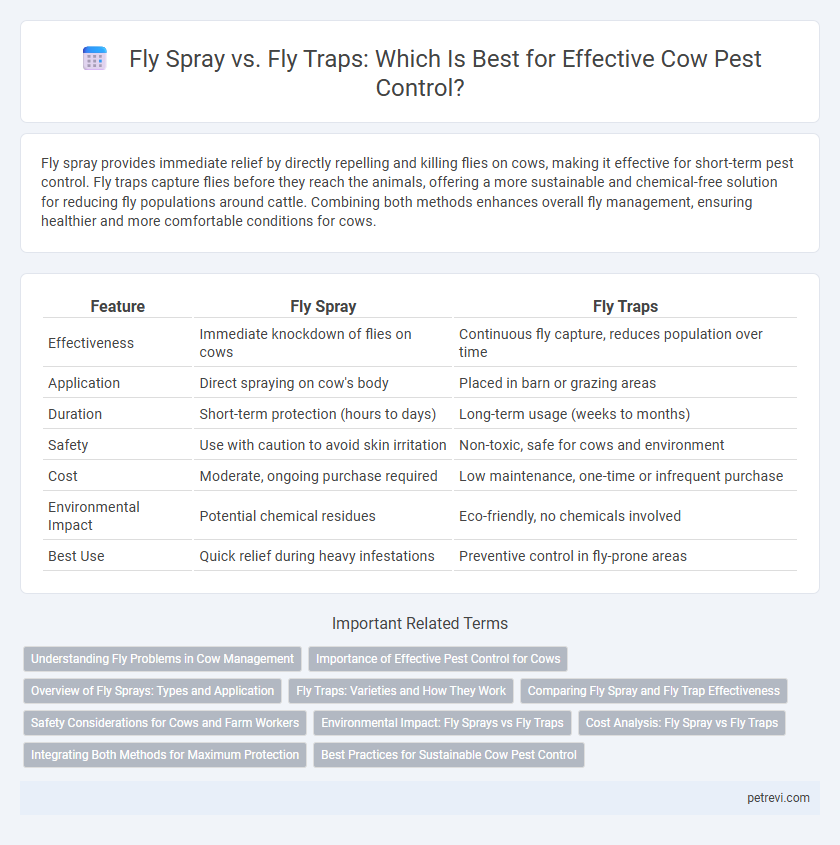Fly spray provides immediate relief by directly repelling and killing flies on cows, making it effective for short-term pest control. Fly traps capture flies before they reach the animals, offering a more sustainable and chemical-free solution for reducing fly populations around cattle. Combining both methods enhances overall fly management, ensuring healthier and more comfortable conditions for cows.
Table of Comparison
| Feature | Fly Spray | Fly Traps |
|---|---|---|
| Effectiveness | Immediate knockdown of flies on cows | Continuous fly capture, reduces population over time |
| Application | Direct spraying on cow's body | Placed in barn or grazing areas |
| Duration | Short-term protection (hours to days) | Long-term usage (weeks to months) |
| Safety | Use with caution to avoid skin irritation | Non-toxic, safe for cows and environment |
| Cost | Moderate, ongoing purchase required | Low maintenance, one-time or infrequent purchase |
| Environmental Impact | Potential chemical residues | Eco-friendly, no chemicals involved |
| Best Use | Quick relief during heavy infestations | Preventive control in fly-prone areas |
Understanding Fly Problems in Cow Management
Effective fly control in cow management requires understanding that stable flies and face flies are the primary pests causing stress and disease transmission in cattle. Fly sprays provide immediate relief by killing flies on contact but often require frequent application to maintain effectiveness. Fly traps reduce the overall fly population by attracting and capturing flies, offering a longer-term, environmentally friendly solution that minimizes chemical use.
Importance of Effective Pest Control for Cows
Effective pest control is crucial for maintaining cow health and productivity, as flies can transmit diseases, cause stress, and reduce milk yield. Fly spray provides immediate relief by repelling and killing flies on contact, while fly traps offer continuous, chemical-free control by capturing flies over time. Integrating both methods enhances overall pest management, promoting animal welfare and farm efficiency.
Overview of Fly Sprays: Types and Application
Fly sprays for cow pest control primarily include synthetic pyrethroids, organophosphates, and botanical insecticides, each targeting various fly species such as horn flies and stable flies. Application methods range from direct spray on cattle to pour-on formulations and spray-on back rubbers, ensuring effective coverage and prolonged protection. Proper application timing and adherence to dosage guidelines are essential to maximize efficacy and minimize resistance development in fly populations.
Fly Traps: Varieties and How They Work
Fly traps for cow pest control come in various types including adhesive traps, baited traps, and electric zappers, each designed to attract and capture flies effectively. Adhesive traps use sticky surfaces to catch flies landing on them, while baited traps lure flies with attractants such as pheromones or food odors, trapping them inside containers. Electric fly traps utilize light to attract flies and then eliminate them through an electric grid, offering a chemical-free method ideal for barns and outdoor cow environments.
Comparing Fly Spray and Fly Trap Effectiveness
Fly spray provides immediate and broad-spectrum control of flies on cows, effectively reducing irritation and disease transmission by directly targeting adult flies on the animal's body. Fly traps, while slower to reduce fly populations, offer a chemical-free, continuous method that captures flies before they reach the cows, addressing the pest problem at the source but requiring strategic placement and maintenance. Combining both methods can enhance overall pest control effectiveness by delivering swift fly reduction with sustainable population management around the herd.
Safety Considerations for Cows and Farm Workers
Fly sprays formulated with veterinary-approved ingredients offer immediate pest control but require careful application to avoid skin irritation or respiratory issues in cows and potential chemical exposure to farm workers. Fly traps provide a non-toxic alternative by physically capturing flies, reducing chemical risks and environmental contamination while requiring regular maintenance to remain effective. Prioritizing safety, using fly traps alongside targeted, low-toxicity sprays minimizes health hazards and ensures a safer environment for livestock and humans.
Environmental Impact: Fly Sprays vs Fly Traps
Fly sprays often contain chemical insecticides that can harm beneficial insects, contaminate soil and water, and contribute to environmental pollution around cattle farms. Fly traps provide a more eco-friendly alternative by physically capturing flies without releasing toxins, reducing chemical residues in the environment. Using fly traps helps maintain ecological balance and decreases the risk of resistance development in fly populations.
Cost Analysis: Fly Spray vs Fly Traps
Fly spray for cow pest control offers immediate and broad-spectrum efficacy but requires frequent application, leading to higher ongoing costs. Fly traps involve a higher initial investment but provide long-term, reusable solutions with minimal maintenance expenses. Evaluating cost-effectiveness depends on herd size and infestation severity, with fly sprays proving costlier over time compared to the sustainability of fly traps.
Integrating Both Methods for Maximum Protection
Integrating fly spray and fly traps offers comprehensive pest control by combining immediate knockdown of flies with long-term population reduction, ensuring sustained cow comfort and health. Fly sprays deliver fast-acting insecticides that target existing flies on the cows, while strategically placed fly traps capture breeding adults before they reproduce, reducing overall fly density. This dual approach minimizes fly-borne diseases and stress, optimizing dairy and beef production efficiency.
Best Practices for Sustainable Cow Pest Control
Fly spray offers immediate relief by effectively repelling and killing flies on cows, but frequent application may harm the animal's skin and environment. Fly traps provide a sustainable alternative by reducing fly populations without chemicals, minimizing resistance and environmental impact. Integrating targeted fly sprays during peak infestation with strategically placed fly traps ensures effective, eco-friendly pest control for cows.
Fly Spray vs Fly Traps for Cow Pest Control Infographic

 petrevi.com
petrevi.com